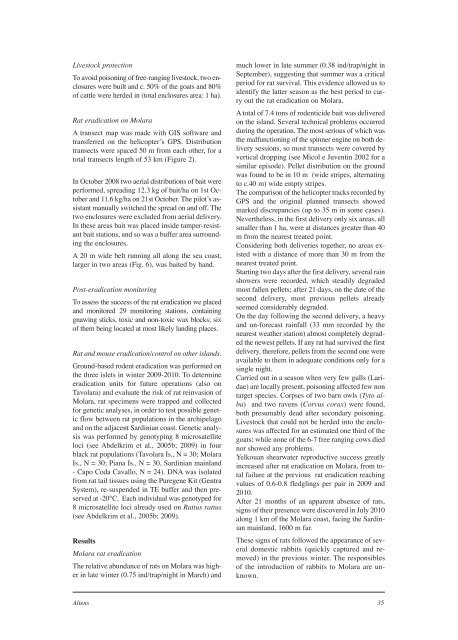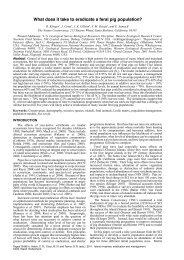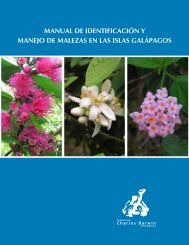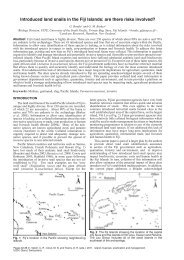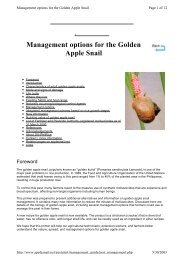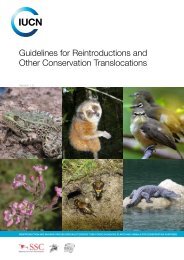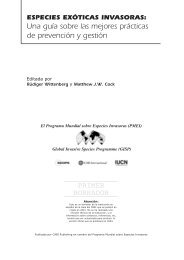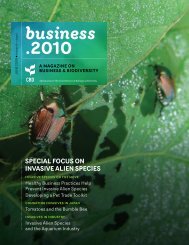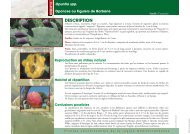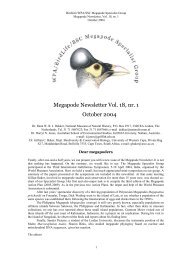Aliens - ISSG
Aliens - ISSG
Aliens - ISSG
Create successful ePaper yourself
Turn your PDF publications into a flip-book with our unique Google optimized e-Paper software.
Livestock protection<br />
To avoid poisoning of free-ranging livestock, two enclosures<br />
were built and c. 50% of the goats and 80%<br />
of cattle were herded in (total enclosures area: 1 ha).<br />
Rat eradication on Molara<br />
A transect map was made with GIS software and<br />
transferred on the helicopter’s GPS. Distribution<br />
transects were spaced 50 m from each other, for a<br />
total transects length of 53 km (Figure 2).<br />
In October 2008 two aerial distributions of bait were<br />
performed, spreading 12.3 kg of bait/ha on 1st October<br />
and 11.6 kg/ha on 21st October. The pilot’s assistant<br />
manually switched the spread on and off. The<br />
two enclosures were excluded from aerial delivery.<br />
In these areas bait was placed inside tamper-resistant<br />
bait stations, and so was a buffer area surrounding<br />
the enclosures.<br />
A 20 m wide belt running all along the sea coast,<br />
larger in two areas (Fig. 6), was baited by hand.<br />
Post-eradication monitoring<br />
To assess the success of the rat eradication we placed<br />
and monitored 29 monitoring stations, containing<br />
gnawing sticks, toxic and non-toxic wax blocks; six<br />
of them being located at most likely landing places.<br />
Rat and mouse eradication/control on other islands.<br />
Ground-based rodent eradication was performed on<br />
the three islets in winter 2009-2010. To determine<br />
eradication units for future operations (also on<br />
Tavolara) and evaluate the risk of rat reinvasion of<br />
Molara, rat specimens were trapped and collected<br />
for genetic analyses, in order to test possible genetic<br />
flow between rat populations in the archipelago<br />
and on the adjacent Sardinian coast. Genetic analysis<br />
was performed by genotyping 8 microsatellite<br />
loci (see Abdelkrim et al., 2005b; 2009) in four<br />
black rat populations (Tavolara Is., N = 30; Molara<br />
Is., N = 30; Piana Is., N = 30, Sardinian mainland<br />
- Capo Coda Cavallo, N = 24). DNA was isolated<br />
from rat tail tissues using the Puregene Kit (Gentra<br />
System), re-suspended in TE buffer and then preserved<br />
at -20°C. Each individual was genotyped for<br />
8 microsatellite loci already used on Rattus rattus<br />
(see Abdelkrim et al., 2005b; 2009).<br />
Results<br />
Molara rat eradication<br />
The relative abundance of rats on Molara was higher<br />
in late winter (0.75 ind/trap/night in March) and<br />
much lower in late summer (0.38 ind/trap/night in<br />
September), suggesting that summer was a critical<br />
period for rat survival. This evidence allowed us to<br />
identify the latter season as the best period to carry<br />
out the rat eradication on Molara.<br />
A total of 7.4 tons of rodenticide bait was delivered<br />
on the island. Several technical problems occurred<br />
during the operation. The most serious of which was<br />
the malfunctioning of the spinner engine on both delivery<br />
sessions, so most transects were covered by<br />
vertical dropping (see Micol e Juventin 2002 for a<br />
similar episode). Pellet distribution on the ground<br />
was found to be in 10 m (wide stripes, alternating<br />
to c.40 m) wide empty stripes.<br />
The comparison of the helicopter tracks recorded by<br />
GPS and the original planned transects showed<br />
marked discrepancies (up to 35 m in some cases).<br />
Nevertheless, in the first delivery only six areas, all<br />
smaller than 1 ha, were at distances greater than 40<br />
m from the nearest treated point.<br />
Considering both deliveries together, no areas existed<br />
with a distance of more than 30 m from the<br />
nearest treated point.<br />
Starting two days after the first delivery, several rain<br />
showers were recorded, which steadily degraded<br />
most fallen pellets; after 21 days, on the date of the<br />
second delivery, most previous pellets already<br />
seemed considerably degraded.<br />
On the day following the second delivery, a heavy<br />
and un-forecast rainfall (33 mm recorded by the<br />
nearest weather station) almost completely degraded<br />
the newest pellets. If any rat had survived the first<br />
delivery, therefore, pellets from the second one were<br />
available to them in adequate conditions only for a<br />
single night.<br />
Carried out in a season when very few gulls (Laridae)<br />
are locally present, poisoning affected few non<br />
target species. Corpses of two barn owls (Tyto alba)<br />
and two ravens (Corvus corax) were found,<br />
both presumably dead after secondary poisoning.<br />
Livestock that could not be herded into the enclosures<br />
was affected for an estimated one third of the<br />
goats; while none of the 6-7 free ranging cows died<br />
nor showed any problems.<br />
Yelkouan shearwater reproductive success greatly<br />
increased after rat eradication on Molara, from total<br />
failure at the previous rat eradication reaching<br />
values of 0.6-0.8 fledglings per pair in 2009 and<br />
2010.<br />
After 21 months of an apparent absence of rats,<br />
signs of their presence were discovered in July 2010<br />
along 1 km of the Molara coast, facing the Sardinian<br />
mainland, 1600 m far.<br />
These signs of rats followed the appearance of several<br />
domestic rabbits (quickly captured and removed)<br />
in the previous winter. The responsibles<br />
of the introduction of rabbits to Molara are unknown.<br />
<strong>Aliens</strong> 35


